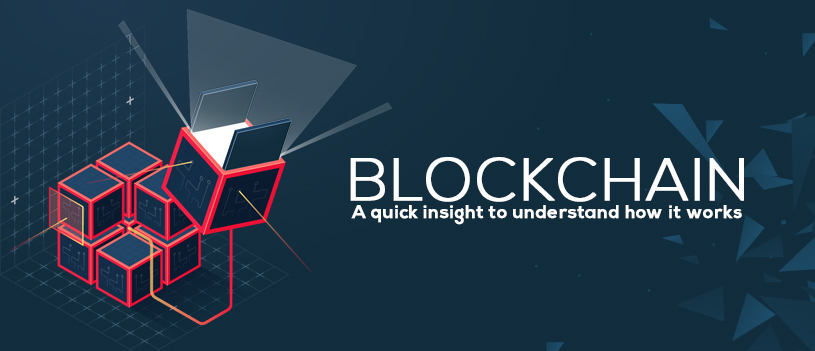With each passing year evolution of computing is touching new horizons. And in this series of evolution, blockchain is termed as the fifth evolution of computing. Blockchain technology is a novel approach towards distributed databases.
Blockchain is actually a distributed database of public or open record confirmed by large number of people having consensual agreement. To put in other words, it is a digital public ledger of data that is shared among a network of independent blockchain community participants.
The ultimate goal of this technology is to address the shortcomings of traditional systems in which transactions are often centralized. More precisely we can say that in traditional systems transactions are controlled by a third party organization. However, blockchain technology supports to create a completely decentralized environment where there is no role of third parties.
Let’s summarize the above discussion for a quick comprehension.
Blockchain is a distributed database that maintains a ever-growing list of data records confirmed by different participating members or nodes. There is no single server and all nodes are connected to one another giving birth to a network. In this network data is recorded in a public ledger that has all the information about each transaction ever happened. As, all the information is shared among all nodes hence it develops a decentralized system that is absolutely transparent.
The blockchain technology first came into existence with the advent of Bitcoin. It is the driving force behind the concept of Bitcoin introduced by Satoshi Nakamoto in 2008. Now, in case of Bitcoin blockchain assures that no one could spend same Bitcoin twice over.
Later on the technology of blockchain which earlier was meant for running Bitcoin only was extended to explore new applications. Its integration with different business models promised immense benefits along with reduction in operational costs, time and complexity.
Different types of Blockchains
- Public Blockchain: As the name suggests this type of structure is open for all participants hence it is known as Public Blockchain. Here anyone can participate in reading, writing, auditing and maintaining the network hence is completely transparent. A consensus mechanism called PoW (Proof of Work) and PoS (Proof of Stake) is followed to take decisions regarding network. In this category crypto currencies like Bitcoin or Litecoin comes having large network having own token.
- Permission Blockchain: This is a large network of nodes but here the activities of community participants are under control. It has its own token but code may or may not be open source. For example Ripple.
- Private Blockchain: As the name signifies such type of network is privately owned by a single entity and hence is centralized. Membership of community participants is controlled hence they cannot freely read, write, audit or maintain the network. Such a blockchain is small and is generally without having own token.
Principles underlying the Blockchain technology
Blockchain has powerfully changed the course of financial transactions affecting the whole fintech industry. In fact, it has the ultimate power to change the way enterprises exchange information. The core of this power lays it its basic principles.
- Distributed Database: Decentralization gives each participant true and complete access to the entire record. This simply means each participant can anytime check the database. Decentralization also signifies that there is no single authority having power to change, hack or manipulate data once stored.
- Peer-to-peer transactions: The network is completely free from all third parties and hence all sorts of communication occur directly among participants. Further, whatever happens on public ledger information regarding that is passed directly to all nodes.
- Transparency and privacy: Every transaction taking place on network is visible to all members. However, still it never compromises with privacy of users as every participant has unique alphanumeric address giving identity complete security.
- Tamper proof record: With unique time stamp it ensures quick tracking of transactions thereby giving an upper hand to its reliability.
- Cryptography: To ensure complete security the network further uses innovative cryptography feature.
How blockchain technology works?
To understand the growing regime of blockchain it is very important to first understand how exactly it works. This technology basically works in a series of steps and only after completion of all steps a transactional process completes.
Step 1: Beginning of transaction
The process begins when a specific community participant transfers funds in form of crypto coins to another participant. This is also known as the first stage of the process.
Step 2: Identity encryption
Blockchain respects privacy and that’s why network always store users not by their name but by giving unique cryptographic keys. These cryptographic keys are of two types public and private to ensure only the user who owns key can access. This procedure ensures no third party can edit transaction and also efficiently trims down chances of fraud and hacking.
Step 3: Creation of Block
When the process begins and is locked by first participant a block is created having encrypted information about the transaction. Here in this step time stamping feature further boosts the security and ensures no double creation of block occurs.
Step 4: Transfer of information to all nodes or Noding
As soon as a block is created a message is broadcasted in the whole network via nodes updating network participants. Nodes here are just the various computers connected to network. Each node of the network confirms each entry by solving an arithmetical problem to validate the new entry. For doing this public verifying and validation work network awards user a digital coin.
Step 5: Verification
This is the last step which starts after the successful verification process. In this complete block is time stamped and is tied together with previously verified blocks. Only after this step the transaction completes and second party receives money.
Concluding thoughts
In the sea of technologies there are hundreds of technologies you can buy to smoothen your business operations. But none of these technologies can offer all the benefits Blockchain alone offers to its users. Already hundreds of forward looking companies have integrated it with their operations and are on the way to dominate.
Moreover, number of businesses adopting it is climbing every day and slowly it is becoming a new standard of business. So, to remain competitive and capture more revenues your enterprise too needs to adopt blockchain.
To know how we can help you to integrate blockchain technology with your business, connect with Webcom Systems now!




